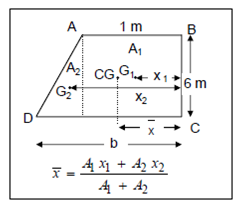Total horizontal pressure:
Total horizontal pressure P = 30 × 6/2 = 90 kN acts at a height of 6/3 = 2 m from the bottom edge C.
If the width of a base of the wall for no tension is 'b' then weight of 1 m width of wall 23 × 1 × (1 + b/2 × 6 ) kN = 69 (1 + b) kN.
It acts by x¯ where x¯ is the distance of CG of this trapezium ABCD from line BC.

x¯ = 1 × 6 × 0.5 + (b - 1) × (6/2) × (b-1/3) +1/1 × 6 + (b - 1) × 6/2
b2 + b + 1/3 (b + 1)
A weight line GE meets the wall base CD; at E such that
EC = b2+b+1/3(b+1), DE =b-EC = 2b2+2b-1/3(b+1)
Hence, eccentricity (e) of the weight,
OE =DE-DO = 2b2+2b-1/3(b+1) - b/2 = b2+b-2/6(b+1)
The net bending moment at base, M = P ⋅ h/3 - W ⋅ OE
= 90 × 2 - 69 (1 + b) b2+ b - 2/6 (1 + b) = 180 - 11.5 (b2 + b - 2) kNm
∴ Minimum bending stress at C = W/ b × 1 - (M. b/2)/ 1 × b3/12 = W/b - 6 M/ b2
69 (1 + b)/b - (1080/b2 -69(b2+b-2/b2))
Here for no tension at base DC the above stress at C must be zero
∴ 69 (1 + b)/b= 1080/b2 - 69 (b2 + b - 2)/b2
giving, b (1 + b) = 15.652 - (b2 + b - 2)
or, b2 + b - 8.826 = 0
Giving b = - 1 ± 6.025/2 = 2.513 m (taking the positive value)
Hence take the base width as 2.6 m.
Maximum pressure at base at point D is
69 (1 + 2.513)/ 2.513 + 6 × [180 - (2.5133 + 2.513 - 2) × 11.5/ 2.5132
96.46 + 96.46 = 192.92 kN/m2